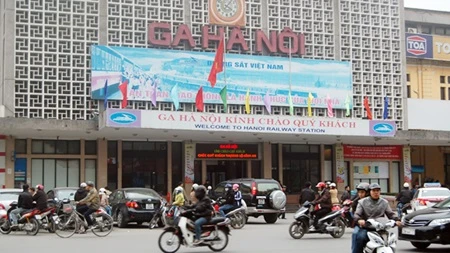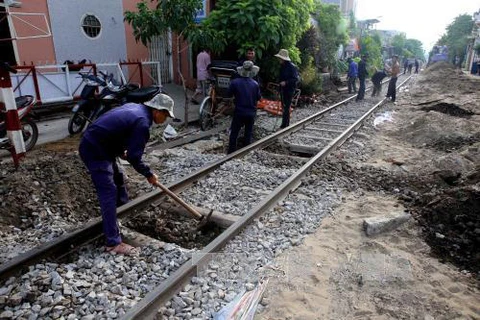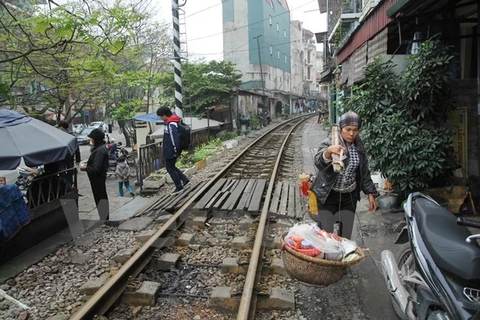Hanoi (VNA) – The Ministry of Transport (MoT) will remove hundreds of below-standard level crossings countrywide to improve rail travel and reduce accidents.
The new regulation on level crossings and construction in railway safety is being built up by the MoT.
For a long time, poor railroad intersections have threatened serious accidents to both train and road users.
Nha Dau level crossing on Hanoi’s Le Duan street, for example, has seen severe congestions every day on rush hours as it is about 80cm higher than the road, obstructing the traffic influx.
Level crossings leading to headquarters of Vietnam National Coal and Mineral Industries Holding Corporation Limited and Vietnam Cement Industry Corporation suffer the same problem. Anytime a car drives through these level crossings, there will be several vehicles stuck in congestions, finding ways to get to Le Duan street.
And it is not just the level crossings with signs and automatic warning systems that have caused problems. Many with barriers have not met required standards.
The level crossing leading to the Agriculture and Rural Development Bank in Phuong Liet ward on Giai Phóng street is trapped between two busy roads.
Since it is narrow and steep, whenever a train is approaching, watchmen always have to prevent drivers from attempting to hurtle cross barriers which may lead to tragic accidents.
Nguyen Dao Viet Phuong, head of Giap Bat Railway Level Crossing Barrier Department, told Giao thong (Traffic) newspaper that the problem is common at the intersections they manage.
Nguyen Van Vinh, deputy head of Railway Infrastructure Management Board under Vietnam Railways (VNR), said there were more than 1,500 level crossings in the country including about 650 of them equipped with barriers, 380 with automatic warning systems and 485 with warning signs. However, up to 80 percent of existing level crossings do not meet standards regulated by the MoT, mostly due to their vision limitation and steep slopes.
According to Vinh, the poor cooperation between localities and the railway sector in land planning and ensuring railway traffic safety, is the main cause of the problem.
In recent years, VNR has implemented projects to upgrade level crossings, especially at more than 900 traffic accident black spots along the country.
Khuong The Duy, deputy head of the Vietnam Railway Authority, said the regulation would touch on new standards to guarantee safe level crossings.
Speed humps will be compulsory at intersections without any watchmen. Waiting lanes and automatic barriers will also be set up while road slope will be reduced.
Responsibility of stakeholders in managing, constructing, maintaining and exploiting level crossings will also be clearly indicated.
“Local authorities will be in charge of coordinating related agencies in their railway traffic safety corridor to ensure clear vision for all vehicles passing though railroad crossings,” said Duy.-VNA
The new regulation on level crossings and construction in railway safety is being built up by the MoT.
For a long time, poor railroad intersections have threatened serious accidents to both train and road users.
Nha Dau level crossing on Hanoi’s Le Duan street, for example, has seen severe congestions every day on rush hours as it is about 80cm higher than the road, obstructing the traffic influx.
Level crossings leading to headquarters of Vietnam National Coal and Mineral Industries Holding Corporation Limited and Vietnam Cement Industry Corporation suffer the same problem. Anytime a car drives through these level crossings, there will be several vehicles stuck in congestions, finding ways to get to Le Duan street.
And it is not just the level crossings with signs and automatic warning systems that have caused problems. Many with barriers have not met required standards.
The level crossing leading to the Agriculture and Rural Development Bank in Phuong Liet ward on Giai Phóng street is trapped between two busy roads.
Since it is narrow and steep, whenever a train is approaching, watchmen always have to prevent drivers from attempting to hurtle cross barriers which may lead to tragic accidents.
Nguyen Dao Viet Phuong, head of Giap Bat Railway Level Crossing Barrier Department, told Giao thong (Traffic) newspaper that the problem is common at the intersections they manage.
Nguyen Van Vinh, deputy head of Railway Infrastructure Management Board under Vietnam Railways (VNR), said there were more than 1,500 level crossings in the country including about 650 of them equipped with barriers, 380 with automatic warning systems and 485 with warning signs. However, up to 80 percent of existing level crossings do not meet standards regulated by the MoT, mostly due to their vision limitation and steep slopes.
According to Vinh, the poor cooperation between localities and the railway sector in land planning and ensuring railway traffic safety, is the main cause of the problem.
In recent years, VNR has implemented projects to upgrade level crossings, especially at more than 900 traffic accident black spots along the country.
Khuong The Duy, deputy head of the Vietnam Railway Authority, said the regulation would touch on new standards to guarantee safe level crossings.
Speed humps will be compulsory at intersections without any watchmen. Waiting lanes and automatic barriers will also be set up while road slope will be reduced.
Responsibility of stakeholders in managing, constructing, maintaining and exploiting level crossings will also be clearly indicated.
“Local authorities will be in charge of coordinating related agencies in their railway traffic safety corridor to ensure clear vision for all vehicles passing though railroad crossings,” said Duy.-VNA
VNA
























